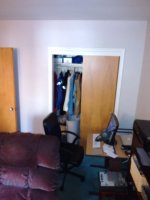My music room is 9.3 x 15.6 x 8.2 feet. At one small end are the speakers and the far wall is mostly a clothes closet with sliding doors that, of course, slide open half-way.
With one of the doors slid over (to the cover the other door, of course), I get a bass response with my 1955 AR-1 that's within 2-3 dB from 20 to 175 Hz (bars 5 dB apart, not calibrated). With the closet closed, within 7-8 dB and looks awful, at least on paper.
Pity we don't have a room acoustics forum. Might be more helpful in achieving good sound than endless minutae of 10th-order sims.
Ben
With one of the doors slid over (to the cover the other door, of course), I get a bass response with my 1955 AR-1 that's within 2-3 dB from 20 to 175 Hz (bars 5 dB apart, not calibrated). With the closet closed, within 7-8 dB and looks awful, at least on paper.
Pity we don't have a room acoustics forum. Might be more helpful in achieving good sound than endless minutae of 10th-order sims.
Ben
Attachments
Does the door rattle or vibrate any? Or is it just the different space?
Insightful question, thanks. No, seems to be just a matter of room geometry and/or stuff stuffed into closet. Not a tuned effect, I'd say.
See picture. This time of year, mostly my heavy winter motorcycle gear.
Sorry for poor picture. Door opening is about 22 inches.
I sure was surprised at the size of the effect. FR goes from pretty poor to pretty darn good by just sliding the door**. It is on the room centre-line and the mic is at my chair (also centre-line). BTW, I couldn't say if the change is compensating for weaknesses of the speaker or undoing harm from the room or both.
The sub* footprint is only about a foot square. So it was easy to find a sweet-spot for it after checking a dozen locations at the other end of the room. Big differences there too. (And I could have gone completely nuts and checked sitting positons too.)
Ben
*I don't plan on using my 1955 AR-1 as a sub indefinitely.... but kind of tickles me to show how good it is. Distortion very favourable too.
**doing the other door does not make things much better
Attachments
Last edited:
You're changing the boundary conditions of the room. This will affect the room modes. You may end up with a sort of diffuser effect from the closet. I've seen a similar effect in my upstairs bedroom where one entire wall is covered by to sliding doors leading to a closet.
Tom
Tom
Accidentally, you made a good bass trap. Several years ago I found (by ear) that slightly opened door of closet has positive impact on low frequencies. Effect changes with summer/winter outfit.
The smoothest and classiest is with Armani. 🙂
The smoothest and classiest is with Armani. 🙂
That's an odd but interesting one. Do you see as much effect if the mic is somewhere else?
To maintain my sanity, I restrict the mic to a closely fixed location where my head would otherwise be. But the lovely flat response does not show up in other locations. I can't say if the particular hills and valleys in my traces would behave similarly in all paired tests elsewhere in the room.
Don't think diffusion is likely from a stuffed clothes closet.
Don't think an odd-shaped closet with loose doors is a bass trap, in the Helmholtz sense.
I think the closet with the open door is absorbing a major eigentone (and harmonic of it) by accidentally being located in a major hot-spot and presenting a stuffed closet instead of a flat wood door. No mystery. On the other hand, no less significant in creating a good HiFi because it is not mysterious.
Ben
Accidentally, you made a good bass trap....
I agree, noticed that REW measurements shows much better low freq response when bathroom door in my room are opened.
I agree, noticed that REW measurements shows much better low freq response when bathroom door in my room are opened.
Motion carried and passed: bass trap. Sound travel inside door is being absorbed by the stuff inside. I bet the responses get even flatter if you fill that closet up with more absorptive material like some wound up sleeping bags/comforters.
Put your mic in the closet opening, and places in the closet. Also several places in the room. Try both doors slid to the center so you have two openings, etc....
Of course the closet is a resonant chamber. Even when empty, drywall on stud construction is fairly absorptive at low frequencies...
Of course the closet is a resonant chamber. Even when empty, drywall on stud construction is fairly absorptive at low frequencies...
Not helpful to confuse resonance and absorption. Or making things even more incoherent by forgetting the closet door which opens an "acoustic hole" disrupts half the eigentones by simple geometry, even if nothing was in the closet.Put your mic in the closet opening, and places in the closet. Also several places in the room. Try both doors slid to the center so you have two openings, etc....
Of course the closet is a resonant chamber. Even when empty, drywall on stud construction is fairly absorptive at low frequencies...
A closet with loose sliding doors and stuffed with motorcycle winter clothes, bedding, a shelf, and other stuff is not "of course" a resonant chamber at all.
Ben
Having read many books on acoustics I never came across "eigentone", but son of a gun, "a standing wave occurs where the sound wave and its reflection are in phase with each other and reinforce each others standing waves". I do think Ron is technically correct that the cavity between the studs on drywall and plaster do resonate, dissipate energy=heat, and thus reduces SPL. That said, I think all these concepts are at play here and the reduction of eigentones/standing waves being the primary.
I would be curious if a few limp mass absorbers might fix the 50-70Hz area that remains but what cool find with the closet.
I would be curious if a few limp mass absorbers might fix the 50-70Hz area that remains but what cool find with the closet.
Don't think so.Having read many books on acoustics... I do think Ron is technically correct that the cavity between the studs on drywall and plaster do resonate, dissipate energy=heat...
Ben
Not helpful to confuse resonance and absorption. Or making things even more incoherent by forgetting the closet door which opens an "acoustic hole" disrupts half the eigentones by simple geometry, even if nothing was in the closet.
A closet with loose sliding doors and stuffed with motorcycle winter clothes, bedding, a shelf, and other stuff is not "of course" a resonant chamber at all.
Ben
Ahhh, I see, so you are a closet expert in search of an acoustics forum, no less.... 😉
Thank you for the jolly good entertainment.Don't think so.
Ben
I can see the forum is full of humourists today.
Small clarification: except for my comments about geometry and eigentones, losses tend to be resolvable to resistance. In the case of treatment by means of resonant traps, the losses are ultimately resistive. But best to keep your head screwed on straight and distinguish absorbent methods (which are present in every room not having 6 concrete walls) from resonant methods (which are exceedingly rare).
There are a whole variety of other means of taming room modes, passive and active*. Lots of ways.
Ben
*might be some smart readers out there who can guess the various connections between motional feedback and room modes
Small clarification: except for my comments about geometry and eigentones, losses tend to be resolvable to resistance. In the case of treatment by means of resonant traps, the losses are ultimately resistive. But best to keep your head screwed on straight and distinguish absorbent methods (which are present in every room not having 6 concrete walls) from resonant methods (which are exceedingly rare).
There are a whole variety of other means of taming room modes, passive and active*. Lots of ways.
Ben
*might be some smart readers out there who can guess the various connections between motional feedback and room modes
Last edited:
- Status
- Not open for further replies.
- Home
- Loudspeakers
- Subwoofers
- My closet door: giant effect




